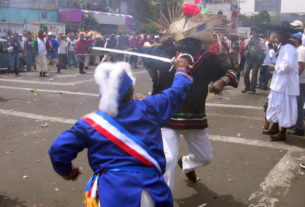Moralistic, prejudiced, racist, misogynist, manipulative, sexist, daring, exciting, critical, sarcastic and passionate – these are just a few adjectives that commonly describe Mexico’s most widely-read publication: the historieta .
The historieta’s origin can be thought of as rather diffuse, considering that it is based on a synthesis of icons and texts wound into a single message. But the historieta’s plot often shares the same archetypes and themes as that of the writing of the Greek and Roman classics, those of ancient Egypt and pre-Hispanic cultures.
Over the course of time, the historieta has nourished itself by feeding off of various artistic disciplines, cosmovisions and technology, and as such makes it difficult to talk about a single, all-encompassing origin. However, in the expert opinion of many historians, the modern historieta and its equivalents in other nations appeared towards the end of the 19th century, almost simultaneously on five different continents. Its appearance and development is intimately linked to the development of the printing press and political cartoons.
A STORY’S TALE
In the specific case of Mexico, the historieta was originally conceived as an advertising strategy in 1880, when cigarette manufacturer El Buen Tono, began publishing a narrative series of lithographs entitled, “Historia de una Mujer,” as an insert in cigarette packs. The author was painter Eusebio Planas, and the vignettes included text appearing at the bottom of the page, instead of the dialogue bubbles currently used.
At the beginning of the 20th century, the same tobacco company began to market a character known as “Ranilla,” the brainchild of illustrator Juan Bautista Urrutia. Later on, El Buen Tono joined forces with Cervecería Moctezuma, and subsequently all characters in the story resolved their problems by smoking a cigarette and drinking a beer.
Little by little, during the first few decades of the 20th century, the historieta began to shape itself through the use of recurring and permanent characters, who in turn began to characterize the historieta. From that point on, several weekly newspapers in Mexico began to publish historietas, many of them after acquiring the rights to republish foreign historietas, while others came from Mexican authors who based their strips on series from the United States.
During the 1930s, the historieta earned its independence from the dailies, and slowly began appearing in magazines and independent comic books. That decade saw a diversification of genre, and the comic books began producing other themes such as heroes, horror stories, science fiction and melodrama.
In the 1940s, the concept of the historieta as a product of individual creativity disappeared. Up to that moment every script, drawing and text was the product of a single author. The rapid, worldwide process of industrialization brought with it a new social rhythm, to which the historieta was not immune. But this, in turn, obliged the historieta to adapt itself to mass production. This merited the beginning of large work teams, whose members were involved in different parts of the process: the illustrator, the scriptwriter, the printer, the painter, the letter designer and the distributor.
Around the same time, industrialization and the political conflict caused by the Second World War consolidated the historieta’s identity, serving as an instrument of political propaganda, as well as a means of social communication and source of popular entertainment.
The historieta based its themes on the construction of a world divided in two – good and evil: the free citizen and the communist threat, socialism and the capitalist monster, the American soldier and the Nazi horror, etc. This bipolar vision of the world was presented in different scenarios: war, the fight against crime, romance, science fiction and fantasy, with moral order as a common denominator and prevailing ideology.
During that time, many historietas with the same motives and influences were imported into Mexico, but it was thanks to the creation of characters and stories springing from a local context, that the historieta succeeded in rooting itself in the collective interest.
In the 1960s, series such as “El Santo – el enmascarado de plata” (based on feats of the namesake wrestler) and “Kalimán-el hombre increíble” (based on the radio soap opera) appeared on the scene. As soon as they hit the market, these two series generated such significant sales that they served as examples to historieta industrialists of the great possibilities the market could hold.
CORNERING A MARKET
Today, the historieta is a powerful industry with the lion’s share of readers in Mexico, surpassing any other printed publication in volume and proliferation. It also enjoys a wide range of distribution, finding its way not only into every corner of Mexico, but also a substantial part of Central America and the southern part of the United States.
Nowadays, there are enormous amounts of historietas circulating in news and magazine stands, that are not limited to recent issues, but also back issues that are no longer published. This points to the presence of a dual market: that of the most recent publications (costing between five to seven pesos) and that of second-hand or out-of-print publications, which can be purchased at a lower price (between one and three pesos).
JUDGING A BOOK BY ITS COVER
In order to get at the heart of the historieta, its many names must be taken into consideration. The term “historieta” is used by those of the guild, for example, the script writers, illustrators, publishers and writers. They are also known as “libros de bolsillo,” literally pocketbooks, even though this term is a bit formal, vague and not commonly used. To collectors and die-hard fans the historieta is known as a “comic tipo Libro Vaquero,” or a cowboy comic book, a concept encompassing all types of historietas.
“El Libro Vaquero” is also the title of the most well-known and successful historieta, referring more specifically to a western comic edited by Novedades publishers, with a circulation of 800,000 copies weekly.
Today, there is an extensive variety of new historieta titles (more than 50 titles by over 10 different publishers), among which are found such titles as: “Relatos de Presidio,” “El Libro Vaquero,” “Amores and Amantes,” “Almas Perversas,” “La Novela Policiaca,” “Demónico’s,” “El Pantera,” “El Solitario” and “Secretas Tentaciones,” among others.
The different titles depend on the central theme of each series, and their function is to present the story line and characters, while orienting the reader towards a specific subject matter. The most common themes are westerns, adaptations of literary works, historical accounts, reports (ecology, public health, natural disasters), day-to-day life and work, sex, daily dramas (domestic conflicts, crimes and social offences), police stories, super heroes (the fight of good against evil) and terror (fiction and legends).
While the content of every historieta varies, it is possible to identify certain general traits. One example is that the historieta does not employ fixed stereotypes as might be expected. Moral judgements are indiscriminately applied to all characters, with the single goal of creating and resolving a central conflict that gives meaning to the story. In almost all cases, evil is represented by one of the seven deadly sins, allowing the reader to easily understand and identify the conflict.
In the case of Police Officer Caty Aguilar, a historieta fan for several years, the title serves as a resource to choose the subject of her preference. “Personally, I like the historietas that deal with love and romance, although I don’t snub other themes, as long as they’re related. I base my decision on the title and the drawings on the front cover . and I prefer titles that create a bit of mystery that piques my curiosity,” she says.
For Aguilar, one of the most attractive points of the historieta is being able to get involved in the plot, either because it coincides with her perception of the world, or because she finds similarities or differences between the story and her work as a police officer.
“Sometimes while I’m reading I think, ‘If I were in their place, I would do this.’ Or, ‘that can’t be true – things happen differently!’ And I try and think how I would resolve the issues presented.”
Entertainment is the magnet that draws readers to the historieta, and as a form of entertainment it would appear to be of greater interest to members of lower socioeconomic groups than to other social sectors. However, in reality, the historieta is a genre of literature unappreciated by intellectuals, that actually falls into the hands of all kinds of readers, breaking with the false notion that it is literature for the lower classes.
PLUGGING VALUES
As has been previously mentioned, since its beginning, the historieta has maintained a close relationship with politics, thanks to its enormous effectiveness as a means of communication. On many occasions, the historieta has been employed by government institutions with the goal of making certain social programs and services known, such as health, prevention, education and public administration. The majority of political parties have used the historieta to make their policies known to voters, or to promote a certain candidate.
Such was the case with Francisco Labastida, the Institutional Revolutionary Party (PRI) presidential candidate in the 2000 elections.
His campaign team published a historieta entitled “Una Vida Ejemplar” (An Exemplary Life), which offered readers a biography of the candidate in 48 illustrated pages. The front cover of the comic depicts a housewife asking her family, “Have you heard about the interesting life of Francisco Labastida?” The mother in this story is responsible for politically involving the family and orienting their vote.
It would appear that the effects of this strategy were not the ones hoped for, and perhaps it would have been more effective to go with a script that at least featured a conflict, victim or moral dilemma.
But the following phenomenon is another factor that influenced this situation: historieta reading has set arenas, and is not accepted in certain contexts. Instead, there are specific places where it is read. For example, in the case of Caty Aguilar, her place for reading is at work.
“I take my breaks (at work) to read, because in my house this type of reading material is looked down on.”
And in general the historieta does not surpass its reading space or time. “In my house I never mention the historietas, I never show them to my children or to anyone else in my family, because I want them to learn with better things.”
It’s likely that with this example, the capacity of penetration is underestimated, but perhaps for years the critical capacity of readers in certain social and political environments has also been underestimated.
“I would be interested in seeing the historieta become more realistic, and speak about the country’s real political situation and corruption. I would like it if there weren’t an exaggeration of reproachable behavior for women, and that human values were recovered, instead of wielding such themes as sex and homosexuality in such an aggressive manner,” says Aguilar.


